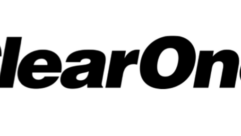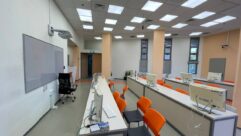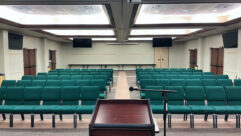
Technology Showcase: Conference-room Boundary Microphones
Sep 1, 2007 12:00 PM,
By Bennett Liles
Meeting audio gets a design update.

Samson Technologies CM10B
While conference-room microphone systems have grown increasingly sophisticated and multifeatured — with automatic mixing, chairman-override functions, priority mic selection, and other processor-controlled options — the boundary microphone still holds a strong place among conference-room microphones. Offering simpler wiring and a less obtrusive appearance, the boundary microphone, particularly in its newer recessed forms, becomes part of the table and is seldom even noticed.
The primary reason that the boundary microphone continues to thrive in the conference room is the fact that you can’t improve on an advantage provided by basic physics. Long ago, a property of fluid dynamics was discovered that produces a pressure zone in the boundary of an air mass passing over a rigid, flat surface. In the boundary layer near the surface (of the conference table, in this case), the air molecules travel more slowly, creating a thin pressure zone in which direct and reflected sound waves are in phase. This produces a 6dB higher sensitivity in a microphone diaphragm placed inside the layer than in one that is outside the pressure zone. For this reason, such microphones are frequently referred to as pressure-zone microphones (PZMs).
The operational result is that sound can be picked up from around the conference table without the need to individually mike the participants. With the appropriate echo cancellation or manual control, they provide a perfectly good solution for videoconferencing or sound recording of meetings for transcription, as well.
Lately, there have been some new developments in design, particularly in the area of permanently flush-mounted styles. Many models now offer variable pickup patterns through easy adjustments in the internal wiring. Let’s have a look at the market, where a solid principle has been given a few new twists.

Avlex BM91BC and BM91WC
THE MARKETPLACE
The AKG Acoustics C 680 BL uses a condenser element phantom powered with 9V to 52V DC to produce a cardioid pickup pattern, and it includes a shock-mounted design to help isolate the element from impacts to the conference table. The mic has a frequency response of 60Hz to 20kHz, an equivalent noise level below 27dBA, an A-weighted signal-to-noise ratio above 67dB, and a sound pressure level for 1 percent total harmonic distortion of up to 115dB. A 10ft. cable terminated with an XLR connector is provided, and a phantom power adapter is included. Optional accessories include the B18 battery power supply and the N 62E AC power supply. The C 680 BL has an MSRP of $317.
The Ansr Audio AM-41 represents the more recent trend in cylindrical flush-mount boundary microphones that become part of the conference table. Powered with a 9V to 52V phantom supply, the AM-41 provides a flat frequency response from 200Hz to 5kHz and a 6dB increase from 6kHz to 10kHz. The microphone has a white finish and is supplied with all necessary mounting hardware. It features a self-contained power module that sends audio output to a standard XLR connector.
The Apex130 from Apex Electronics is a surface-mount condenser microphone with a variety of uses, from conference rooms to recording stage plays. The unit provides a semi-cardioid pattern with a frequency response from 50Hz to 18kHz and an impedance of 250Ω with a sensitivity of -68dB. The condenser element is powered by phantom voltage from 9V to 48V DC with a current drain of approximately 2mA. The mic can handle a maximum input sound pressure level of 130dB and produces a signal-to-noise ratio of greater than 65dB. The product includes a 26ft. cable terminated with a mini XLR connector and a mini XLR-to-standard XLR adapter. The MSRP is $209 but, with some shopping, the Apex130 can be found for less than $140.
Astatic Commercial Audio Products offers the 930VP boundary microphone in black and white models (930VPW) featuring a multifunction mute switch and a selectable high-pass filter. The microphone’s pickup pattern may be adjusted to best suit the acoustics of the conference room by dialing the pattern desired over a continuous range from omnidirectional to unidirectional. The 930VP is also equipped with a soft-membrane mute switch that can be programmed to operate in push-to-talk, push-to-mute, and push-on/-off modes. In the push-on/-off mode, the unit can be set to power up in on or off switched mode. An LED indicates when the talk switch is on. The frequency response is 40Hz to 15kHz with an impedance of 130V and a maximum SPL input of 118dB. The full-featured 930VP may be found for less than $200.

Crown International PZM-10
The ES947 cardioid condenser microphone from Audio-Technica mounts into a conference table or other flat surface to provide clear, non-phase-distorted sound pickup. Equipped with UniGuard RFI shielding technology, the ES947 offers a solution in environments where RF interference might present a problem. The use of isolators mounted around the shaft inside the tabletop may minimize mechanical shock. Available in a black or white finish, the mic is powered with 11V to 52V DC. Exhibiting a frequency response of 40Hz to 12kHz, the product can handle sound pressure levels up to 142dB and output its signal at 200V through a male XLR connector. The ES947 has an MSRP of $225.
The Audix ADX-60 pre-polarized condenser microphone offers a selection of polar patterns including cardioid, hypercardioid, and omnidirectional, depending on the element ordered with the model. The unit is encased in a zinc die-cast base with a low-reflective, black e-coat finish. It comes with a detachable 25ft. shielded cable with mini Switchcraft 3-pin/male XLR connector and an inline preamp and works on phantom power of 9V to 52V. The optional APS-911 power supply can operate on either phantom or battery power. The omni element (ADX60-om) provides a frequency response of 20Hz to 18kHz, while the other elements produce a response of 50Hz to 18kHz. The mic can take up to 130dB sound pressure levels and offers a signal-to-noise ratio of 65dB. The ADX-60 is available for just more than $200.
The BM91 series from Avlex features an interchangeable condenser element to provide a selection of polar patterns including omnidirectional, cardioid, and supercardioid. Powered by 22V to 48V DC, the mic offers a 30Hz to 20kHz frequency response with a signal-to-noise ratio of 65dB in its low-noise, balanced, inline preamps; 100dB dynamic range; and sensitivity of -65dB. A 12ft. cable terminated with a male XLR connector is provided. The product is available in a black or white finish and includes a custom paint mask. The MSRP is $188.
The low-cut filter on the Beyerdynamic MPC 65 acoustical boundary microphone eliminates room rumble and roar and provides higher gain before feedback. The half-spherical polar pattern works well for roundtable discussions, and the microphone’s high sensitivity pulls in speech from a distance. The electret condenser element is powered by 8V to 52V phantom at 3.4mA, and it can handle SPL levels up to 124dB with an effective output level of -36dBm. Versions are available in a black or white finish and offer either a cable or an integral XLR or 1/4in. connector. The MPC 65 can be found for less than $250.

DPA Microphones BLM4060
The Bogen SCU250 unidirectional surface-mount mic touts a heavy copper base, a non-glare matte black finish, and mounting keyways for wall or table attachment. Powered with 9V to 52V DC phantom, the unit offers a 20Hz to 18kHz frequency response, a signal-to-noise ratio above 65dB, and a maximum SPL handling capability of 130dB. The hefty case weighs in at 1lb. and comes with a 26ft. low-impedance microphone cable terminated in a standard XLR. The SCU250 can be found for just more than $100.
The newest addition to the CS-RF series from Clockaudio, the CS4-RF, provides a four-element microphone in a single, very durable, non-reflective solid brass housing with a black Nextel or Satin Nickel finish and bottom cable exit. Upon handling the CS4-RF, one is immediately impressed with the weight and solid feel of it. Four half-cardioid polar patterns give coverage of an entire conference table in either temporary or permanent mounting situations. RF protection of the internal phantom power module allows operation that is free of interference from PDAs and cell phones. The unit has a frequency response of 50Hz to 18kHz with a signal-to-noise ratio of 65dB. The microphone operates on 9V to 48V phantom power and can handle a maximum SPL of 125dB. All models are supplied with a 6.5ft. unterminated multicore cable.
The U.K. has a strong entry with the C200 from Communication Technology. The boundary electret condenser microphone is powered with 24V to 48V DC with 3.0mA current. An integral LED indicates when the unit is powered. A soft neoprene molding isolates the case from vibrations in the conference table, and a variation, the C200/PTT/W, includes a latching on/off switch. The polar pattern is semi-cardioid with a 50Hz to 18kHz frequency response, and the maximum SPL handling with 1 percent distortion is 130dB. The 15ft. cable supplied with the microphone has a mini XLR female connector at the mic end and an XLR male connector on the mixer end. The C200 is available for less than $350.

Peavey Electronics PSM 3
The PZM-10 pressure-zone microphone from Crown International represents a more recent approach in flush-mounting microphones into conference tables and other flat surfaces. The unit’s tubular housing fits a 25in.-to-32in. hole and almost disappears into the table. The mic runs on 12V to 48V phantom power and provides a mic-level signal on an XLR connector, while the PZM-10LL operates on 12V to 24V DC and offers a line-level output on an unterminated cable. The longest optimum voice pickup range is about 3ft. The frequency response on the PZM-10 is 80Hz to 20kHz; the PZM-10LL has slightly less bass response. The polar pattern is hemispherical, and the maximum SPL handling level with 3 percent total harmonic distortion is 130dB. The signal-to-noise ratio at 94dB SPL is 68dB. The unit is available in an off-white or black finish, but it may be painted. The MSRP is $200.
DPA Microphones offers the BLM4060 boundary layer microphone in an attractive metallic finish. The unit is a pre-polarized, omnidirectional miniature condenser with a 5.4mm vertical diaphragm powered through the DPA adapter at 5V to 50V. The maximum SPL handling spec before clipping is 134dB, and the signal-to-noise ratio at 94dB SPL is 71dB with a 100dB dynamic range. Delivered with a DAD6001 adapter and a 10ft. cable, the BLM4060 is compatible with a wide range of power supplies and cable adapters. The product may be found in the $600 range.
As the name implies, the PolarChoice boundary satellite from Electro-Voice offers a selectable range of patterns including omnidirectional, cardioid, supercardioid, and figure-8. Any current Electro-Voice or Telex body-pack transmitter may be inserted into the custom-designed compartment under the PolarChoice’s housing, which fits over the body-pack transmitter like a turtle shell. Included is a programmable, top-mounted membrane mic mute switch that can be set up for momentary or latching operation in push-to-talk and push-to-mute modes. The mic is powered from the body-pack transmitter at 5V with less than 1.5mA current and offers a 50Hz to 20kHz frequency response, 130dB maximum SPL handling, and switchable high-pass selection. The MSRP on the PolarChoice is $498.

Sennheiser e 912 S
The Gold Line CBM1 offers a superior maximum SPL handling capability of 150dB, making it suitable for pickup of drums and pianos and working in other stage scenarios in addition to conference table applications. A three-position, low-frequency rolloff selector and a power switch are included on the painted aluminum case. The polar pattern is omnidirectional with a wide 20Hz to 20kHz maximum frequency response, depending on the bass rolloff setting, for clear pickup of very low-volume voices. The unit may be powered with an internal 9V battery or from 12V to 48V phantom. The CBM1 carries a list price from Gold Line of $145.
The CM-601 boundary microphone from JTS features a half-cardioid pickup pattern and a frequency response of 30Hz to 12kHz. The unit includes a red LED indicator, a three-position low-cut switch and a membrane on/off switch that can be programmed for push on/push off, push to talk, and push to mute. It offers a sensitivity of -53dB, a maximum SPL handling of 125dB at 1kHz, and a signal-to-noise ratio of 67dB. The CM-601 is run with 36V to 52V phantom power with a current drain up to 6mA.
The MP-30 pressure-zone condenser microphone from Milab Microphones AB has a hemispherical pattern and is powered from a 12V-to-52V phantom supply with a current drain of 1mA. Used for piano and other musical instrument pickups as well as in conference rooms, the microphone offers a frequency response of 40Hz to 20kHz and a maximum SPL handling capability of 110dB. The MP-30 has an A-weighted noise level of 24dB and sensitivity of 9mV at 1kHz. The microphone is supplied with an XLR-terminated 6.5ft. cable. Milab also offers a phantom power supply that can run two microphones simultaneously on 48V DC with XLR input and output connectors. The MP-30 can be found for around $500.
The Nady Systems CBM 40 boundary microphone is powered with either mixer-supplied 9V to 52V DC phantom or through the Nady 48V SMPS-1 phantom power supply. The cable included has a mini XLR connector on the mic end and a standard XLR male connector on the mixer end. The microphone has a unidirectional pickup pattern and a frequency response of 50Hz to 18kHz. To minimize surface vibrations picked up through the conference table, the unit is equipped with a rubber pad installed on the bottom of the die-cast alloy housing. The current MSRP for the product is $69.95.
The Peavey Electronics PSM 3 back-electret condenser boundary microphone contains a wide range of unidirectional condenser capsules for a choice of pickup patterns. The microphone comes in a non-reflective black case with a soft, shock-absorbing pad under it. It is powered with 9V to 52V DC phantom at 5mA current through a detachable cable. The unit provides a frequency response of 50Hz to 20kHz with a sensitivity of -35 dBV/Pa and a maximum SPL handling level of 130dB. The dynamic range is 106dB with a signal-to-noise ratio of 68dB. With a little shopping, the PSM 3 can be found for less than $130.
Billed as the smallest form factor wireless boundary microphone in the world, the Revolabs Solo tabletop wireless boundary microphone provides coverage for up to three people seated around a conference table. Optimized for the human voice, the unit exhibits a frequency response of 100Hz to 8kHz and may be AC- or battery-powered with up to eight hours on a single charge. Using spread spectrum transmission, the microphone also provides 128-bit encryption for security.
The CM10B unidirectional boundary microphone from Samson Technologies features a half-cardioid pickup pattern. The microphone housing contains an internal high-pass filter and a heavy neoprene rubber pad on the bottom for minimizing room rumble and noise from table thumping. The condenser element runs on 9V to 52V phantom power at 4mA, and the 30ft. cable has a mini XLR connector at the microphone end and a standard XLR male connector at the mixer end. All electronics are contained in the mic body, eliminating the need for any external electronics pack. The CM10B provides a 30Hz to 18kHz frequency response with a signal-to-noise ratio of 70dB, a dynamic range of 103dB, and a maximum SPL handling level of 127dB. The CM10B is available for less than $100.
For a very small footprint (32mm diameter) in a surface-type table microphone, the Sanken Microphone CUB-01 miniature high-fidelity boundary microphone is worth considering. Featuring a flat frequency response down to 70Hz, the unit comes in two versions in gray or beige — the CUB-01, which operates on 48V phantom power at 2.2mA, and the CUB-01-PT (pigtail), which runs on 3V to 10V DC at less than 1.5mA for wireless applications. The CUB-01 offers a maximum SPL capability of 122dB, is supplied with a 10ft. cable, and carries an MSRP of $449. The CUB-01PTBE and CUB-01PTGY versions with pigtail cable for wireless transmitter connection list for $349.
Designed for the Schoeps Microphones Colette system, a full range of modular microphone components, the BLM3 PZM microphone capsule fits with the CMC 6U amplifier body to produce a boundary microphone with conference table application providing a 20Hz to 20kHz frequency response, an A-weighted signal-to-noise ratio of 82dB, and 128dB maximum SPL handling. Available in a matte gray finish, the BLM3 has an MSRP of $1,031. The CMC 6U supplying 12V or 48V phantom power and balanced output retails for $720.
Designed especially for conference room applications and speech recording, the Sennheiser e 912 S features a pre-polarized condenser element with a half-cardioid pickup pattern. A number of response curves can be selected with an internal DIP switch. This same type of switch allows the integral membrane switch to be programmed in push on/push off, push-to-talk, push-to-mute, or always-on modes. The base contains a shock-absorbing rubber pad and mounting slots. The unit is available in black, white, or non-reflective Nextel gray. The microphone runs on 48V phantom with a current drain of 1.4mA and, at 1kHz, it exhibits a 134dB maximum SPL handling capability. The e 912 S in black or white retails for $375, while the Nextel gray model carries a price of $420.
The MX692 wireless boundary microphone from Shure has an integrated UC wireless transmitter compatible with UC, UHF, and UP series receivers. The unit, powered by an internal 9V battery, has an LED power light that indicates battery status by the color displayed. The touch-sensitive switch is programmable for touch-to-mute or touch-to-activate modes of operation. The frequency response is 50Hz to 17kHz with a dynamic range of 100dB. An alkaline battery will power the unit for approximately seven hours. The MSRP for the MX692 is $798.
For More Information
AKG Acoustics
www.akg.com
Ansr Audio
www.ansraudio.com
Apex Electronics
www.apexelectronics.com
Astatic Commercial Audio Products
www.astaticinstalled.com
Audio-Technica
www.audio-technica.com
Audix
www.audixusa.com
Avlex
www.avlex.com
Beyerdynamic
www.beyerdynamic.com
Bogen
www.bogen.com
Clockaudio
www.clockaudio.com
Communication Technology
www.communication-technology.co.uk
Crown International
www.crownaudio.com
DPA Microphones
www.dpamicrophones.com
Electro-Voice
www.electrovoice.com
Gold Line
www.gold-line.com
Milab Microphones AB
www.milabmic.com
Nady Systems
www.nady.com
Peavey Electronics
www.peavey.com
Revolabs
www.revolabs.com
Samson Technologies
www.samsontech.com
Sanken Microphone
www.sanken-mic.com
Schoeps Microphones
www.schoeps.de
Sennheiser
www.sennheiserusa.com
Shure
www.shure.com
Bennett Lilesis a freelance television production engineer and AV technician in the Atlanta area. He specializes in government video production, distance learning, and videoconferencing.










